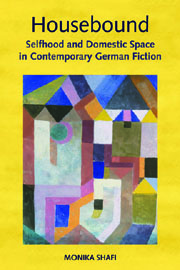Book contents
- Frontmatter
- Contents
- Acknowledgments
- List of Abbreviations
- Introduction
- 1 Bodies, Biographies, and Buildings: Jenny Erpenbeck's Heimsuchung and Katharina Hacker's Der Bademeister
- 2 House Inheritance: Arno Geiger's Esgeht uns gut and Katharina Hagena' Der Geschmack von Apfelkernen
- 3 Escaping to the Countryside: Walter Kappacher's Selina oder Das andere Leben and Monika Maron's Endmoränen
- 4 Uncanny Houses: Select Narratives by Judith Hermann, and Susanne Fischer's Die Platzanweiserin
- 5 Open Houses: Emine Sevgi Özdamar's “Der Hof im Spiegel” and Seltsame Sterne starren zur Erde: Wedding-Pankow 1976/77
- 6 (Un)safe Houses: Katharina Hacker's Die Habenichtse and Ian McEwan's Saturday
- Conclusion
- Bibliography
- Index
3 - Escaping to the Countryside: Walter Kappacher's Selina oder Das andere Leben and Monika Maron's Endmoränen
Published online by Cambridge University Press: 05 February 2013
- Frontmatter
- Contents
- Acknowledgments
- List of Abbreviations
- Introduction
- 1 Bodies, Biographies, and Buildings: Jenny Erpenbeck's Heimsuchung and Katharina Hacker's Der Bademeister
- 2 House Inheritance: Arno Geiger's Esgeht uns gut and Katharina Hagena' Der Geschmack von Apfelkernen
- 3 Escaping to the Countryside: Walter Kappacher's Selina oder Das andere Leben and Monika Maron's Endmoränen
- 4 Uncanny Houses: Select Narratives by Judith Hermann, and Susanne Fischer's Die Platzanweiserin
- 5 Open Houses: Emine Sevgi Özdamar's “Der Hof im Spiegel” and Seltsame Sterne starren zur Erde: Wedding-Pankow 1976/77
- 6 (Un)safe Houses: Katharina Hacker's Die Habenichtse and Ian McEwan's Saturday
- Conclusion
- Bibliography
- Index
Summary
The two novels discussed in this chapter — Walter Kappacher's Selina oder Das andere Leben (2005, Selina or The other life) and Monika Maron's Endmoränen (2002, End moraines) — trace movements opposite to Geiger's and Hagena's texts. In the latter narratives, the protagonists entered the houses in question by chance and with reluctance; they suddenly needed to come to terms with a family history that was for the most part burdensome and painful. In Selina and Endmoränen, on the other hand, the main characters are drawn to houses that quickly turn into objects of single-minded desire. Half-ruined, these houses need extensive renovation, consuming substantial resources and time, but the process of fixing them up also evolves into an alternative lifestyle. In each case, the house offers the tenants a unique space by means of which they hope to wrest control over their lives. Not coincidentally, these houses are found in remote spots — on a hill in Tuscany (Selina) and in a village close to the Polish border (Endmoränen) — signaling that isolated, rural environments are best suited for introspection and change. Each protagonist is fascinated not so much by the particular house as by its location and its promise of difference. Each delights in the setting's unique light, air, and views so different from those of the urban homes left behind. In these distant areas, they hope to apprehend nature, beauty, and history in a more profound manner.
- Type
- Chapter
- Information
- HouseboundSelfhood and Domestic Space in Contemporary German Fiction, pp. 81 - 109Publisher: Boydell & BrewerPrint publication year: 2012



